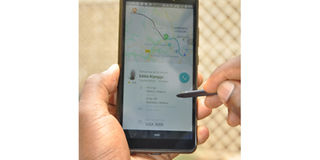Why you are addicted to your smartphone

A customer uses a smartphone to schedule a trip. The smartphone is likely to remain the focus of investment budgets for many years to come. PHOTO BY ERONIE KAMUKAMA
What you need to know:
- FEW READ. Consumers’ scrutiny of the terms and conditions associated with apps or devices remains scant: About 80 per cent of adults rarely read them.
In the half-dozen years since they became mainstream, smartphones have become the most-used consumer electronic device.
As a result, the smartphone market has reached maturity, with adoption levels nearing their natural plateau in Uganda. Over the next 12 months, growth in smartphone adoption is likely to be immaterial, and the market will level out in terms of units sold.
So, how are consumers using all those smartphones, apps, and accessories? We focused on five key themes:
The smartphone has become integral to many people’s lives. Smartphones are embedded into many people’s daily routines, not just because of the applications available for smartphones themselves, but also because of the growing array of devices that smartphones enable.
Smartphones are used to configure smart speakers, display data collected by fitness trackers, online purchases, relay images from security cameras, process data shown on smartwatches, store music played on earbuds, and to configure smart lights. The more such ancillary devices a consumer acquires, the more vital and used the smartphone becomes.
The smartphone is also likely to remain the focus of investment budgets for many years to come. The vast market means that investments in new processors, machine learning capabilities, computational photography, display technology, and connectivity are likely to focus more on smartphones than on any other type of device, such as tablets.
The market for smartphone apps and accessories is immense and growing rapidly. Even if smartphone unit sales are leveling off, the broader smartphone economy—sales of hardware, content, and services for this ubiquitous device—is booming. We expect that such “smartphone multiplier” sales will drive high increases in revenue in 2020 alone, estimated at 15 per cent increase higher than last year 2019.
The smartphone multiplier’s aggregate value should grow in the medium term, as two of its major product categories—wireless headphones and wireless charging—remain in their relative infancy or early growth stage, with only a minority of smartphone owners having acquired these products so far.
Users don’t seem worried about controlling their smartphone use. As smartphones have become more integral to people’s lifestyles, a great deal on how, when, and why people use them has been explored.
Past results reveal that most consumers reach for their phones within half an hour of waking, while those in younger age groups admit to overusing their phones at night, after lights out. So it is not surprising that a large proportion of the population perceive that they overuse their smartphones.
Over users appear to be apathetic about better controlling their smartphone use — despite the growing range of tools that are available to manage excessive usage. Only 6 per cent of smartphone users, for instance, use screen time trackers—far fewer than the 48 percent who self-report as over users.
Mobile phones and games have always made a compelling pair. Even in the golden era of the “huge brick” GSM phones, with their monochrome screens and numeric keyboards, a preloaded game became a differentiator. Our phones never leave Our side, and games are a welcome distraction.
Consumers are sharing a lot of data, sometimes without being aware of the terms and conditions. The past year has seen an increase in the number and gravity of negative media and news stories regarding data privacy.
Some countries have also completed their first year under the GDPR (General Data Protection Regulation), and one of its main purposes is to make it easier for citizens to understand how their data is being used.
In the last 12 months, the volume and range of the data that consumers share has grown in most countries. This may be partly because the number of connected devices each individual owns is growing, and the vast majority of these devices share data with third parties.
However, consumers’ scrutiny of the terms and conditions associated with apps or devices remains scant: About 80 per cent of adults rarely read them.
The writer is the managing director and global leader for the technology, media and telecommunications (TMT) at Stalworth Consulting Group.




